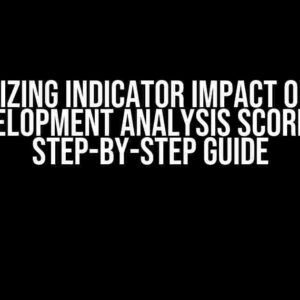Are you tired of tediously iterating through your data, performing calculations, and creating new columns? Do you want to take your data manipulation skills to the next level? Look no further! In this article, we’ll dive into the world of advanced logic with Pandas, focusing on the trifecta of groupby, apply, and transform. We’ll explore how to compare row values with previous values and create new columns with ease.
What You’ll Learn
- How to use groupby to segment your data and perform calculations
- The power of apply: moving beyond simple aggregation
- Transforming your data with custom functions and lambda
- Comparing row values with previous values using groupby and apply
- Creating new columns with calculated values using transform
Setting the Stage: Sample Data
To illustrate these concepts, let’s create a sample dataset. Imagine we’re working with a table of stock prices, with columns for date, symbol, and closing price.
import pandas as pd
data = {'date': ['2022-01-01', '2022-01-02', '2022-01-03', '2022-01-04', '2022-01-05',
'2022-01-01', '2022-01-02', '2022-01-03', '2022-01-04', '2022-01-05'],
'symbol': ['AAPL', 'AAPL', 'AAPL', 'AAPL', 'AAPL',
'GOOG', 'GOOG', 'GOOG', 'GOOG', 'GOOG'],
'closing_price': [150.0, 152.5, 155.0, 157.5, 160.0,
2000.0, 2025.0, 2050.0, 2075.0, 2100.0]}
df = pd.DataFrame(data)
print(df)
| date | symbol | closing_price |
|---|---|---|
| 2022-01-01 | AAPL | 150.0 |
| 2022-01-02 | AAPL | 152.5 |
| 2022-01-03 | AAPL | 155.0 |
| 2022-01-04 | AAPL | 157.5 |
| 2022-01-05 | AAPL | 160.0 |
| 2022-01-01 | GOOG | 2000.0 |
| 2022-01-02 | GOOG | 2025.0 |
| 2022-01-03 | GOOG | 2050.0 |
| 2022-01-04 | GOOG | 2075.0 |
| 2022-01-05 | GOOG | 2100.0 |
Groupby: Segmenting Data for Calculations
Groupby is a powerful method for segmenting your data into groups based on one or more columns. This allows you to perform calculations on each group independently.
# Group by symbol and calculate the mean closing price
grouped_mean = df.groupby('symbol')['closing_price'].mean()
print(grouped_mean)
symbol AAPL 154.5 GOOG 2042.5 Name: closing_price, dtype: float64
Apply: Moving Beyond Simple Aggregation
Apply takes groupby to the next level by allowing you to perform custom calculations on each group. This is where the magic happens!
# Define a custom function to calculate the daily return
def daily_return(group):
group['daily_return'] = group['closing_price'].pct_change()
return group
# Apply the custom function to each group
df_applied = df.groupby('symbol').apply(daily_return)
print(df_applied)
| date | symbol | closing_price | daily_return |
|---|---|---|---|
| 2022-01-01 | AAPL | 150.0 | nan |
| 2022-01-02 | AAPL | 152.5 | 0.017543 |
| 2022-01-03 | AAPL | 155.0 | 0.016393 |
| 2022-01-04 | AAPL | 157.5 | 0.016129 |
| 2022-01-05 | AAPL | 160.0 | 0.015625 |
| 2022-01-01 | GOOG | 2000.0 | nan |
| 2022-01-02 | GOOG | 2025.0 | 0.0125 |
| 2022-01-03 | GOOG | 2050.0 | 0.012195 |
| 2022-01-04 | GOOG | 2075.0 | 0.012121 |
| 2022-01-05 | GOOG | 2100.0 | 0.012048 |
Transform: Creating New Columns with Calculated Values
Transform is a method that allows you to create new columns with calculated values. It’s similar to apply, but with a more concise syntax.
# Create a new column with the daily return using transform
df['daily_return'] = df.groupby('symbol')['closing_price'].transform(lambda x: x.pct_change())
print(df)
| date | symbol | closing_price | daily_return |
|---|---|---|---|
| 2022-01-01 | AAPL | 150.0 | nan |
| 2022-01-02 | AAPL | 152.5 | 0.017543 |
| 2022-01-03 | AAPL | 155.0 | 0.016393 |
| 2022-01-04 |



